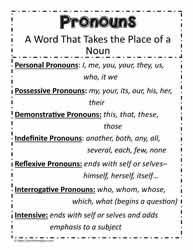Pronouns are words that replace nouns in a sentence. They help avoid repetition and make sentences smoother and easier to understand. For example, instead of saying “Mary said Mary is going to Mary’s house,” we can say “Mary said she is going to her house.” In this chapter, we will learn about three types of pronouns: Personal Pronouns, Reflexive Pronouns, and Possessive Pronouns.
- Personal Pronouns
Personal pronouns are used to replace specific nouns that refer to people or things. They change depending on whether they are the subject (doing the action) or the object (receiving the action) in a sentence.
Types of Personal Pronouns:
- Subject Pronouns: Used as the subject of a sentence.
– Examples: I, you, he, she, it, we, they
– Usage:
– “I am going to the park.”
– “She loves to read books.”
– “They are playing football.”
- Object Pronouns: Used as the object of a verb or preposition.
– Examples: me, you, him, her, it, us, them
– Usage:
– “John gave me a gift.”
– “The teacher called him.”
– “We went with them to the zoo.”
How to Use Personal Pronouns:
– Use subject pronouns when the pronoun is doing the action.
– Use object pronouns when the pronoun is receiving the action.
Exceptions:
– Sometimes, the pronoun “you” can be both a subject and an object pronoun.
– Example: “You are my friend.” (subject)
“I will call you later.” (object)
- Reflexive Pronouns
Reflexive pronouns are used when the subject and the object of a sentence are the same person or thing. They end in -self (singular) or -selves (plural).
Examples of Reflexive Pronouns:
– Singular: myself, yourself, himself, herself, itself
– Plural: ourselves, yourselves, themselves
Usage:
– “I hurt myself while playing.”
– “She taught herself how to play the piano.”
– “They prepared themselves for the test.”
How to Use Reflexive Pronouns:
– Use reflexive pronouns when the action reflects back on the subject.
– They are often used with verbs like enjoy, hurt, teach, prepare, etc.
Exceptions:
– Reflexive pronouns are not used after prepositions of place. Instead, use object pronouns.
– Incorrect: “She sat by myself.”
– Correct: “She sat by me.”
- Possessive Pronouns
Possessive pronouns show ownership or possession. They replace possessive nouns (e.g., “Mary’s book” becomes “her book”).
Examples of Possessive Pronouns:
– Singular: mine, yours, his, hers, its
– Plural: ours, yours, theirs
Usage:
– “This book is mine.”
– “Is this pen yours?”
– “The red car is theirs.”
How to Use Possessive Pronouns:
– Use possessive pronouns to show who owns something.
– They do not need an apostrophe (‘) because they already indicate possession.
Exceptions:
– Do not confuse possessive pronouns with possessive adjectives (my, your, his, her, its, our, their). Possessive adjectives are followed by a noun, while possessive pronouns stand alone.
– Example: “This is my book.” (possessive adjective)
“This book is mine.” (possessive pronoun)

















